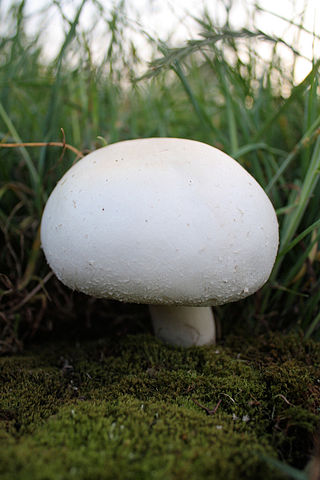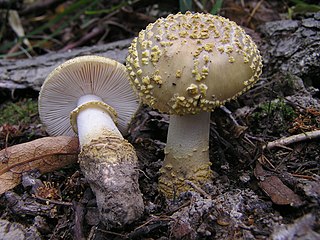
The genus Amanita contains about 600 species of agarics, including some of the most toxic known mushrooms found worldwide, as well as some well-regarded edible species. This genus is responsible for approximately 95% of the fatalities resulting from mushroom poisoning, with the death cap accounting for about 50% on its own. The most potent toxin present in these mushrooms is α-Amanitin.

Amanita pantherina, also known as the panther cap, false blusher, and the panther amanita due to its similarity to the true blusher, is a species of fungus found in Europe and Western Asia.

Amanita porphyria, also known as the grey veiled amanita or the porphyry amanita, is a fairly common, inedible mushroom of the genus Amanita found in Europe and North America.

Amanita citrina, commonly known as the false death cap or citron amanita, is a basidiomycotic mushroom, one of many in the genus Amanita. It grows in silicate soil in the summer and autumn months. It bears a pale yellow or sometimes white cap, with white stem, ring and volva. Though not deadly, it is inedible and often confused for the lethal death cap.

Macrolepiota procera, the parasol mushroom, is a basidiomycete fungus with a large, prominent fruiting body resembling a parasol. It is a fairly common species on well-drained soils. It is found solitary or in groups and fairy rings in pastures and occasionally in woodland. Globally, it is widespread in temperate regions.

Amanita cokeri, commonly known as Coker's amanita and solitary lepidella, is a mushroom in the family Amanitaceae. The mushroom is poisonous. First described as Lepidella cokeri in 1928, it was transferred to the genus Amanita in 1940.

Agaricus arvensis, commonly known as the horse mushroom, is a mushroom of the genus Agaricus.

Agaricus campestris is a widely eaten gilled mushroom closely related to the cultivated button mushroom Agaricus bisporus. It is commonly known as the field mushroom or, in North America, meadow mushroom.

Orson Knapp Miller Jr. was an American mycologist. He published numerous papers in mycology and was responsible for the naming of many taxa, as well as being one of the authors erecting the genus Chroogomphus. He described Omphalotus olivascens, several species of Amanita, and the ghoul fungus Hebeloma aminophilum.

Leucoagaricus leucothites, the white dapperling, or white Agaricus mushroom, is a species of agaric fungus. The species was originally described as Agaricus leucothites by Carlo Vittadini in 1835, and bears similarity to species of that genus. Solomon Wasser transferred it to Leucoagaricus in 1977. While sometimes regarded as edible, the species is suspected of being poisonous due to gastric-upset-causing toxins. It could also be confused with the deadly Amanita ocreata.

Amanita vaginata, commonly known as the grisette or the grisette amanita, is an edible mushroom in the fungus family Amanitaceae. Unlike many other Amanita mushrooms, A. vaginata lacks a ring on the stem. The cap is gray or brownish, 5 to 10 centimetres in diameter, and has furrows around the edge that duplicate the gill pattern underneath. It has a widespread distribution in North America, and is thought to be part of a species complex that includes other similar-looking Amanitas.

Amanita abrupta, commonly known as the American abrupt-bulbed amanita or the American abrupt-bulbed lepidella, is a species of fungus in the family Amanitaceae. Named for the characteristic shape of its fruit bodies, this white Amanita has a slender stem, a cap covered with conical white warts, and an "abruptly enlarged" swollen base. This terrestrial species grows in mixed woods in eastern North America and eastern Asia, where it is thought to exist in a mycorrhizal relationship with a variety of both coniferous and deciduous tree species.

Amanita daucipes is a species of fungus in the family Amanitaceae of the mushroom order Agaricales. Found exclusively in North America, the mushroom may be recognized in the field by the medium to large white caps with pale orange tints, and the dense covering of pale orange or reddish-brown powdery conical warts on the cap surface. The mushroom also has a characteristic large bulb at the base of its stem with a blunt short rooting base, whose shape is suggestive of the common names carrot-footed lepidella, carrot-foot amanita, or turnip-foot amanita. The mushroom has a strong odor that has been described variously as "sweet and nauseous", or compared to an old ham bone, or soap. Edibility is unknown for the species, but consumption is generally not recommended due its position in the Amanita subgroup Lepidella, which contains some poisonous members.

Amanita onusta, commonly known as the loaded Lepidella, the gunpowder Lepidella or the gunpowder amanita, is a species of fungus in the mushroom family Amanitaceae. It is characterized by its small to medium-sized fruit bodies that have white to pale gray caps crowded with roughly conical, pyramidal, or irregular gray warts. The stipe is whitish-gray with woolly or wart-like veil remnants, and at the base is a spindle- or turnip-shaped base that is rooted somewhat deeply in the soil. The species is distributed in eastern North America, from Nova Scotia to Mexico, and may be found growing on the ground in deciduous forests, particularly those with oak, hickory and chestnut. Fruit bodies smell somewhat like bleaching powder, and their edibility is unknown, but possibly toxic.

Amanita franchetii, also known as the Franchet's amanita, is a species of fungus in the family Amanitaceae. It was given its current name by Swiss mycologist Victor Fayod in 1889 in honor of French botanist Adrien René Franchet. A. franchetii occurs in Europe and North Africa with oaks, chestnuts, and pines.

Amanita atkinsoniana, also known as the Atkinson's amanita, is a species of fungus in the family Amanitaceae. It is found in the northeastern, southeastern, and southern United States as well as southern Canada, where it grows solitarily or in small groups on the ground in mixed woods. The fruit body is white to brownish, with caps that measure up to 12.5 cm (5 in) in diameter, and stems up to 20 cm long and 2.5 cm (1 in) thick. The surface of the cap is covered with reddish-brown to grayish-brown conical warts. The stem has a bulbous base covered with grayish-brown scales. The fruit bodies smell faintly like bleaching powder. Although not known to be poisonous, the mushroom is not recommended for consumption.

Amanita ravenelii, commonly known as the pinecone lepidella, is a species of fungus in the family Amanitaceae. The fruit bodies are medium to large, with caps up to 17 cm (6.7 in) wide, and a stem up to 25 cm (9.8 in) long and 3 cm (1.2 in) thick. The warts on the whitish cap surface are large—up to 6 mm (0.24 in) wide and 4 mm (0.16 in) high. The stem has a large bulb at its base, covered with whitish to brownish scales, that may root several centimeters into the soil. The ring on the stem is thick and cotton- or felt-like. It is widely distributed in mixed and deciduous forests of the southeastern United States, where it grows solitarily or in groups on the ground in late summer and autumn. The mushrooms have a unique odor resembling bleaching powder.

Amanita eliae is an inedible species of fungi in the family of Amanitaceae found in Europe. It was described by Lucien Quélet in 1872. Synonyms include Amanitaria eliae, Amanita godeyi, and Amanita cordae.

Amanita excelsa, also known as the European false blushing amanita, is a species of agaric fungus in the family Amanitaceae. It is found in Asia, Europe, and North America, where it grows in deciduous forests.

Amanita mutabilis is a species of Amanita from eastern United States. Amanita mutabilis has pink tones on the cap and stem, and will turn pink when its flesh is cut; it smells of anise.





















